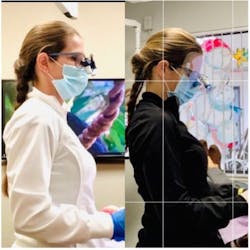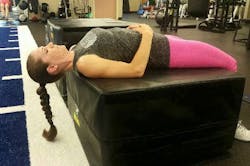Wellness Corner: 5 steps to neck preservation
What you'll learn in this article
- How ergonomic dental loupes minimize neck strain by reducing forward flexion and protecting cervical spine health
- Simple stretching techniques dental professionals can use chairside to relieve tight neck muscles and improve posture
- Evidence-based neck strengthening exercises that counteract muscle imbalances caused by prolonged chairside work
- Mobility and posture mindfulness strategies that help dentists and dental hygienists prevent chronic musculoskeletal disorders
Up to 78.4% of dentists1 and 60% dental hygienists2 report neck pain. Shocked? Yeah, neither am I. We all know it’s a problem and many have taken steps to reduce it for themselves, but neck pain isn’t a one-trick pony. It’s more of a dark barn full of horse-sized causes that we struggle to wrangle in at once. I’m going to shed some light on the top five steps we can use to preserve our necks while practicing in dentistry.
No. 1: Deflective “ergo” loupes
They’ve been all the rage in the last five years for a reason. For the first time in decades, magnification has beat ergonomic training (mildly) for the highest ergonomic impact.3 The reason for this change is beautifully simple: loupes reduce neck flexion to neutral (0-5*) versus 20-60* previously deemed “safe” when using traditional Galilean loupes. See figure 1. The amount of intervertebral disc pressure is even and significantly reduced; the soft tissues don’t become inflamed and compress nerves when the body’s natural cervical lordosis is achieved. Pain reduction is consistent. As an ergonomic specialist, the biggest fear I hear around buying them is “not being able to get used to them.” Using loupes of any variety is a learned skill; this is no different. Practice at home for a few minutes each day for a week or so to establish the neuromuscular patterns that create confidence in movement and then take them in to work on a patient.
No. 2: Stretching chronically tight muscles is a major contributor to pain reduction
There are approximately 30 muscles in the neck, and when less than ideal ergonomics are routinely used, those muscles can become short, tight, and imbalanced, creating dysfunction and pain. The upper trap and deep cervical anterior muscles are commonly tight and can easily be stretched chairside (including with patients who are often experiencing neck pain), between patients, or during morning huddles. Teams that stretch together, stay together! Stretching can be done for as little as five seconds, and studies show that incorporating stretching increases ergonomic mindfulness during treatment.4 It’s a win-win!
No. 3: Strengthening the neck is also important, but don’t go looking for the “neck machine” at the gym
Given our lifestyle choices of an average screen time of 4 hours and 37 minutes in neck flexion, plus the 8 hours a day we look down into an oral cavity, it’s no surprise that the anterior neck muscles are not only tight, but they’re also weak. They don’t put in the work of their counterparts on the back of the neck and hence atrophy from lack of use. Strengthening those muscles (after stretching) can provide a great deal of stability for the neck and help relieve the posterior muscle strain. How? Try a neck plank (see figure 2). Lie on a bench with the head off the side, only supported by one hand. Use the other to chin tuck the neck into neutral position so that the ears are in line with the shoulders, then release both hands and hold the neck in place for as long as possible. Remember: there is no minute like a plank minute—expect this to be hard!
No. 4: Movement maintenance is achieved through mobility, or the ability to safely move the body through space in a joints-full range of motion
Too often, dental professionals can’t look over their dominant shoulder without neck or shoulder discomfort after years of practice. Retaining a healthy range of motion is absolutely essential and is achieved through consistently moving into the edge of that range. For the neck, this can be done by placing the chin down onto the chest then moving it slowly along the collar bone and up to the shoulder. From here look as far over the shoulder as possible, then intentionally tip the head back while bringing the chin upward and over to the other shoulder, making sure the chin is going to the extent of the existing upward range. Look over the opposite shoulder, then sweep the chin down along the opposite collar bone back to the center. Repeat in reverse.
No. 5: Mindfulness is shown to reinforce all the steps above4
This includes stopping during a procedure to correct poor working posture and reset the body to finish. The goal is to always practice with the ears over the shoulders, over the hips (knees and ankles if standing). This neutral posture is absolutely possible when employing ergonomic practices while remaining mindful of the body. I routinely recommend a self-evaluation of photos taken of you during practice (when you don’t know you’re being watched). Knowledge is power, so when we know that we have forward head posture or practice with consistent neck flexion, we can take active steps to correct that—even if it means bringing in an ergo coach to help.
With these five steps, it is possible to preserve a healthy neck and even reduce neck pain—in the op and after!
Editor’s note: This article first appeared in Clinical Insights newsletter, a publication of the Endeavor Business Media Dental Group. Read more articles and subscribe.
References
- Ohlendorf D, Naser A, Haas Y, et al. Prevalence of musculoskeletal disorders among dentists and dental students in Germany. Int J Environ Res Public Health. 2020;17(23):8740. doi:10.3390/ijerph17238740
- Netanely S, Luria S, Langer D. Musculoskeletal disorders among dental hygienist and students of dental hygiene. Int J Dent Hyg. 2020;18(2):210-216. doi:10.1111/idh.12428
- Lietz J, Ulusoy N, Nienhaus A. Prevention of musculoskeletal diseases and pain among dental professionals through ergonomic interventions: a systematic literature review. Int J Environ Res Public Health. 2020;17(10):3482. doi:10.3390/ijerph17103482
- Nye WH, Partido BB, DeWitt J, Kearney RC. Prevention and reduction of musculoskeletal pain through chair-side stretching among dental hygiene students. J Dent Hyg. 2021;95(1):84-91.
About the Author

Katrina Klein, RDH, CEAS, CPT
Katrina Klein, RDH, CEAS, CPT, is a 15-year registered dental hygienist, national speaker, author, competitive bodybuilder, certified personal trainer, certified ergonomic assessment specialist, and biomechanics nerd. She’s the founder of ErgoFitLife, where she teaches that ergonomics and fitness are a lifestyle to prevent, reduce, and even eliminate workplace pain.


